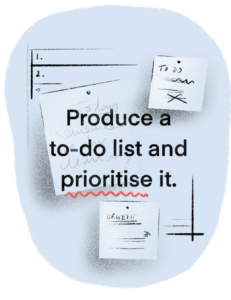Writing is one of my ultimate pleasures in life. It brings me huge joy.
Another would be cooking. I love trying new things out and then sharing these with family and friends. Sometimes I follow a recipe, other times I head off-piste.
I even sometimes combine these two things – I write a blog which is mostly about food and dining (www.tomitr.com), and I also like to post pictures and reviews of my creations and those of others, on Instagram.
So, when I was asked to contribute a recipe or two to a brilliant cookbook from fabulous communicators, I leapt at the chance.
By leapt at the chance, I mean I got excited by the idea and spent a lot of time thinking (overthinking, if we’re honest) about what my killer recipe idea might be. And then I didn’t do it.
I thought so much about the options, but never reached a decision. So even when I was nudged, I was no nearer to the conclusion.
That meant that when my beautiful copy of ‘Can Comms Cook’ landed on my doorstep, I knew that I wasn’t in it. Instead of seeing my own recipes in print, I see those of my friends, colleagues and peers.
I worried too much about what recipe to share, whether it’d be good enough, and whether with more time I’d come up with something better. Others didn’t, or if they did, they got over that in enough time.
I’ll enjoy the cookbook, because it’s a fantastic thing created by brilliant, productive people. In fact, it’s better than I could have imagined. The recipes are a diverse mix of cuisines and the illustrations that accompany them are just beautiful.
I wish I had a recipe in it!
There are a few lessons that I can take from this experience. Inevitably, these stretch beyond cooking:
Don’t let perfection be the enemy of good
This is something I truly believe, and it’s something I really need to practice. In the busy world we live in, we don’t always have time to ensure everything we deliver is the very best it can be. We need to accept that and ensure that what we do produce is good (sometimes, the bar is simply ‘good enough’).
When I look at the day job, I don’t know a single communicator that isn’t spinning countless plates. We all want to write the perfect piece that reaches and engages every audience with every key message. But it’s not always possible.
But in almost all instances, something produced by a professional communicator is better than the nothing you might achieve if you strive for perfection.
Prioritisation
I know that time management is one of my weaknesses. I always assume things will take me less time to complete than they do, and I don’t always prioritise the things that are most important or urgent. 
If this is you, and you know it, then do something about it. There are lots of tools and strategies for better managing your time, but for me, the simplest is most effective – I produce a to-do list and then I prioritise it.
The second part is crucial. This is so I don’t just tick off the easiest things on the list or those I enjoy the most.
Doing this means I have more time for the things I really enjoy – like writing this blog.
What about that recipe?
The lovely people at Alive with Ideas who produced the cookbook have taken pity on me. They’ve allowed me to submit a recipe with this blog. I live in hope it’ll make it into a second volume of the book.
I’ve thought long and hard (the right amount of long and hard) and have gone with Tunisian lamb stew.
When I went to uni, I worked in the college bar and dining room. Between my first and second years it went through a bit of a rebrand. Out went soggy burgers and rock-hard jacket potatoes, and in came amazing cuisine from around the world.
One of the best dishes on the menu was Tunisian lamb stew. It was a rich and sweet dish, filled with delicious tender meat and fruit which melted into what was a thick and unctuous sauce. It was on the rotating menu once a fortnight, and I always made sure to be there that day.
I even asked the chef for the recipe, which he not only hand wrote for me, but also scaled down the catering sized quantities for the home chef. Sadly, I lost that recipe a long time ago, but the memories of the meal have stayed with me.
Sabrina Ghayour includes a similar recipe in her Persiana Everyday cookbook. So, the recipe below is inspired by both versions and my own tinkering.
The truth is, if you cook the lamb slowly for a long time, then you can pick and choose the herbs, spices and fruit to your own taste. The uni version included dates and apricots, so they both feature here. But plums and prunes would also work. The sweetness is softened by the strength of the lamb and the slow cooking.
800g-1kg lamb (I used shoulder, but neck fillet or a slow cooked leg would also work)1 large or 2 small onion(s), sliced
4 cloves garlic, crushed or sliced
2 tsp of finely chopped or grated ginger
1 tsp ground cumin
1 tsp ground coriander
1 tsp turmeric
0.5 tsp cinnamon
0.5 tsp cloves (to taste)
1 tsp sweet paprika
2 bay leaves
6 large dates, chopped (I used medjool, as it was Christmas when I last made this)
12 dried apricots, chopped
A generous squeeze of honey or pomegranate molasses (or other sweetener)
Salt and pepper
400g tin tomatoes (I use whole rather than chopped)
In a casserole, fry your onion in olive oil for a few minutes until soft. Add the garlic and ginger and cook for another 1-2 minutes.Add your spices, stir and cook for another minute until fragrant.
Add a little water if it’s too dry.
At this point, brown your lamb meat. You want this cut into bite-size chunks. Slightly larger is better because the slow cooking will ensure the meat melts away.
Stir and season the dish. Add the dates and apricots and your tomatoes. Use a wooden spoon to break these up a little if you prefer.
Add your honey
Bring the dish to the boil and then reduce the temperature and leave it to simmer.
Put a lid on the dish and then leave it for the magic to happen. The longer you have to do this, the better, but I’d suggest at least 75 minutes.
If you prefer, you can do this in the oven at a temperature of about 140-160 C.
I serve the dish with some cous cous jewelled with raisins, but it’d work with mash or rice or even on a jacket potato.
Once ready, remove the bay leave. Garnish generously with your favourite green herb – I’m a coriander man, but parsley would work just as well. Flaked almonds also work well on top – they bring a welcome contrast to your Instagram pictures too.
If you have the time, why not make some eastern side dishes or homemade breads to accompany the fragrant stew?
Enjoy!
And what of the other recipes I was considering? Well, you can look out for those on my blog. If you already follow me, you’ll see that this year I’ve already managed to find more time for writing.
By Ian Curwen for Alive with Ideas
Want a copy for yourself? Download the recipe card
















